Recovered from the Wayback Machine.
It is difficult to be sympathetic to people in Iowa and Missouri when you read some webloggers who gloat about how “well” their state did compared to how well the people did in New Orleans after Katrina. I think it’s time to take a closer look at events; to get some perspective on both events.
Early estimates put the number of damaged or lost homes in Iowa at about 8,000 to 10,000 homes, based on the number of displaced people. I estimate from the numbers I’ve heard in the last few weeks that Missouri will end up with about 500 to 1000 damaged or destroyed homes.
The number of homes destroyed by Katrina varies widely, but I’ve seen estimates from 275,000 to over 850,000 homes, many of them in New Orleans. In fact, 80% of the city was impacted, and only 45% of the New Orleans population has been able to return to New Orleans, years after the storm.
I couldn’t find numbers of people killed in the recent floods here in the midwest, but from an old estimate, we lost about 30 people. Over 1836 people died from Katrina, and the long term impact of the flood could result in thousands more dying.
Though we like to think floods along the Mississippi are sudden, this one was not. We had all the indications of a bad flood building up along the Mississippi beginning in April. The people impacted by New Orleans had three days, four tops, to prepare.
The people in Missouri and Iowa were not cut off and isolated. Most had neighbors and friends who helped. The people in New Orleans were shoved into a coliseum or left marooned on damaged bridges, as the surrounding communities would not let them leave the city. Why? Because rumors talked about roving bands of thugs shooting everything in sight; rumors proven to be untrue, but still persisting in places like Wikipedia—an article I nominate for being the worst edited, most inaccurate, and outdated article in Wikipedia. These people were left without water and food, in intense heat for days. No comfortable Red Cross shelters for them.
River floods like the recent flooding in the Midwest impact across class lines, especially after the federal buy outs resulting from the the 1993 flood. The flood in New Orleans impacted on some of the poorest people in this country. People who were then bused as far away as Salt Lake City, and cut adrift.
This recent flooding is terrible, and I don’t want to downplay the awfulness of the event, or the extent of the damage and the help that will be needed to rebuild in Iowa and Missouri. At the same time, it angers me to see those pontificating in how “better” we handled the flood than the folks handled Katrina in New Orleans and the rest of the south. Especially when the purpose for such comparisons is politically, and even racially, motivated.
Additional


